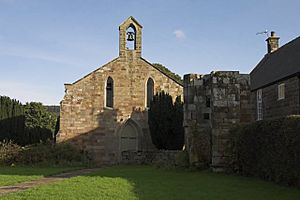Rosedale Priory facts for kids
Rosedale Priory was a special religious building in Rosedale Abbey, a village in North Yorkshire, England. It was a home for nuns, who are women dedicated to a religious life. The priory was started sometime between 1150 and 1199. Even though the village is called Rosedale Abbey, the building itself was a priory, which is a smaller type of religious house than an abbey.
Contents
What Was Rosedale Priory?
Rosedale Priory was a place where a group of nuns lived, prayed, and worked. These nuns belonged to the Benedictine order, a very old Christian group. They followed rules set by Saint Benedict. The land for the priory was given by a man named Robert III de Stuteville. He wanted the nuns to have a place to worship and to farm the land around them.
When Was Rosedale Priory Built?
The priory began to be built when King Henry II was ruling England. It was finished during the time of King Richard the Lionheart. This means it was built a very long time ago, in the 12th century!
The Priory's End
Rosedale Priory was closed down in 1535. This happened during the time of King Henry VIII, when many religious houses in England were closed. This event is known as the Dissolution of the Monasteries. When it closed, there was one prioress (the head nun) and eight other nuns living there.
What Happened to the Building?
After the priory was closed, it was left empty. People believe that most of its stones were used again to build other parts of the village. These stones might have been used for homes or even the nearby Church of St Mary and St Lawrence.
Today, only a small part of the original priory remains. It's a 13th-century turret, which is a small tower. This turret stands about 20 feet (6 meters) tall. You can find it just west of the current church. This old turret is considered an important historical building. It was given a special "grade II listed" status in 1953, which means it's protected because of its history.


